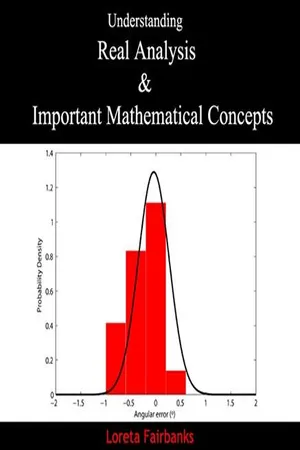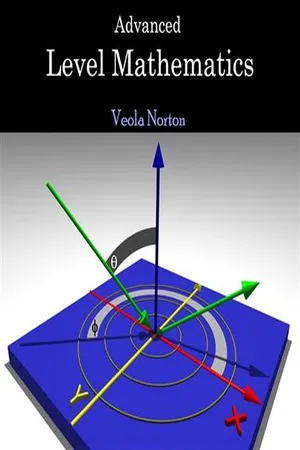Mathematics
Implicit differentiation
Implicit differentiation is a technique used to differentiate equations that are not explicitly expressed in terms of one variable. It involves differentiating both sides of an equation with respect to the variable of interest, treating the other variables as functions of it. This method is particularly useful for finding derivatives of equations that are difficult to solve explicitly.
Written by Perlego with AI-assistance
Related key terms
1 of 5
5 Key excerpts on "Implicit differentiation"
- eBook - PDF
Anton's Calculus
Early Transcendentals
- Howard Anton, Irl C. Bivens, Stephen Davis(Authors)
- 2018(Publication Date)
- Wiley(Publisher)
129 3 We begin this chapter by extending the process of differentiation to functions that are either difficult or impossible to differentiate directly. Next we will develop a number of new derivative formulas that include the derivatives of logarithmic, exponential, and inverse trigonometric functions. Later in the chapter, we will consider some applications of the derivative. These will include some new methods for finding rates of change as well as the use of linear functions to approximate nonlinear functions. Finally, we will discuss L’H ˆ opital’s rule, a powerful tool for evaluating limits. TOPICS IN DIFFERENTIATION 3.1 Implicit differentiation In this section we will describe a method for differentiating functions that are not expressed in the form y = f (x). FUNCTIONS DEFINED EXPLICITLY AND IMPLICITLY An equation of the form y = f (x) is said to define y explicitly as a function of x. However, sometimes functions are defined by equations not of this form. For example, the equation yx + y + 1 = x (1) defines y as a function of x since it can be rewritten as y = x − 1 x + 1 We say that (1) defines y implicitly as a function of x, the function being f (x) = x − 1 x + 1 x y x y x 2 + y 2 = 1 y = √1 − x 2 x y y = − √ 1 − x 2 Figure 3.1.1 An equation in x and y can implicitly define more than one function of x. For example, if we solve the equation of the circle x 2 + y 2 = 1 (2) for y in terms of x, we obtain y = ± √ 1 − x 2 , so we have found two functions that are defined implicitly by (2), namely, f 1 (x) = √ 1 − x 2 and f 2 (x) = − √ 1 − x 2 (3) The graphs of these functions are the upper and lower semicircles of the circle x 2 + y 2 = 1 (Figure 3.1.1). This leads us to the following definition. 3.1.1 definition We will say that a given equation in x and y defines the function f implicitly if the graph of y = f (x) coincides with a portion of the graph of the equation. - eBook - PDF
- Doug French(Author)
- 2004(Publication Date)
- Continuum(Publisher)
Chapter 12 The Calculus: Differentiation and Integration There is no part of mathematics for which the methods of approach and development are more important than the calculus ... the early development must be gradual ... it will be found that pupils who have learnt to apply processes mechanically are mystified by the principles, and are therefore liable to serious error in any matter that is slightly outside the usual routine. (The Teaching of Calculus in Schools, Mathematical Association, 1951) ALGEBRA AND CALCULUS Since the calculus is far too big a subject to discuss in a single chapter in a book on algebra, I have chosen to use this final chapter to exemplify the ideas about teaching and learning algebra developed in this book by discussing some selected aspects of the calculus and its application to problems. Derivatives and integrals are concerned with two very important ideas: the gradient of a curve, with its links to rate of change, and the area under a curve with its links to summation. It is customary to introduce derivatives before integrals, but practice varies with regard to the approach to integration. One approach is to define it as an anti-derivative and then to show that it can be used to determine the area under a curve. The idea of an anti-derivative is obviously relevant when it comes to differential equations, but it does not seem to be the obvious starting point for considering integrals because it lacks an immediate purpose. The other approach is to define integrals directly in terms of the area under a curve and then let it emerge that the process of finding an integral is the reverse of finding a derivative. This second approach has the considerable merit of letting the link between differentiation and integration, the fundamental theorem of the calculus, emerge as a surprise. - No longer available |Learn more
- (Author)
- 2014(Publication Date)
- Orange Apple(Publisher)
This definition is fundamental in differential geometry and has many uses. • Differentiation can also be defined for maps between infinite dimensional vector spaces such as Banach spaces and Fréchet spaces. There is a generalization both of the directional derivative, called the Gâteaux derivative, and of the differential, called the Fréchet derivative. • One deficiency of the classical derivative is that not very many functions are differentiable. Nevertheless, there is a way of extending the notion of the derivative so that all continuous functions and many other functions can be differentiated using a concept known as the weak derivative. The idea is to embed the continuous functions in a larger space called the space of distributions and only require that a function is differentiable on average. • The properties of the derivative have inspired the introduction and study of many similar objects in algebra and topology. • The discrete equivalent of differentiation is finite differences. The study of differential calculus is unified with the calculus of finite differences in time scale calculus. ________________________ WORLD TECHNOLOGIES ________________________ Integral A definite integral of a function can be represented as the signed area of the region bounded by its graph. Integration is an important concept in mathematics and, together with differentiation, is one of the two main operations in calculus. Given a function ƒ of a real variable x and an interval [ a , b ] of the real line, the definite integral is defined informally to be the net signed area of the region in the xy -plane bounded by the graph of ƒ , the x -axis, and the vertical lines x = a and x = b . The term integral may also refer to the notion of antiderivative, a function F whose derivative is the given function ƒ . In this case, it is called an indefinite integral , while the integrals discussed here are termed definite integrals . - No longer available |Learn more
- (Author)
- 2014(Publication Date)
- Orange Apple(Publisher)
This definition is fundamental in differential geometry and has many uses. • Differentiation can also be defined for maps between infinite dimensional vector spaces such as Banach spaces and Fréchet spaces. There is a generalization both of the directional derivative, called the Gâteaux derivative, and of the differential, called the Fréchet derivative. • One deficiency of the classical derivative is that not very many functions are differentiable. Nevertheless, there is a way of extending the notion of the derivative so that all continuous functions and many other functions can be differentiated using a concept known as the weak derivative. The idea is to embed the continuous functions in a larger space called the space of distributions and only require that a function is differentiable on average. • The properties of the derivative have inspired the introduction and study of many similar objects in algebra and topology. • The discrete equivalent of differentiation is finite differences. The study of differential calculus is unified with the calculus of finite differences in time scale calculus. ________________________ WORLD TECHNOLOGIES ________________________ Integration A definite integral of a function can be represented as the signed area of the region bounded by its graph. Integration is an important concept in mathematics and, together with differentiation, is one of the two main operations in calculus. Given a function ƒ of a real variable x and an interval [ a , b ] of the real line, the definite integral is defined informally to be the net signed area of the region in the xy -plane bounded by the graph of ƒ , the x -axis, and the vertical lines x = a and x = b . The term integral may also refer to the notion of antiderivative, a function F whose derivative is the given function ƒ . In this case, it is called an indefinite integral , while the integrals discussed here are termed definite integrals . - eBook - PDF
The Calculus Lifesaver
All the Tools You Need to Excel at Calculus
- Adrian Banner(Author)
- 2009(Publication Date)
- Princeton University Press(Publisher)
C h a p te r 8 Implicit differentiation and Related Rates Let’s take a break from trying to work out how to differentiate everything in sight. It’s time to look at Implicit differentiation, which is a nice generalization of regular differentiation. We’ll then see how to use this technique to solve word problems involving changing quantities. Knowing how fast one quantity is changing allows us to find how fast a different, but related, quantity is changing too. Anyway, the summary for this chapter is the same as the title: • Implicit differentiation; and • related rates. 8.1 Implicit differentiation Consider the following two derivatives: d dx ( x 2 ) and d dx ( y 2 ) . The first is just 2 x , as we’ve seen. So isn’t the second one 2 y ? That would be the answer if the differentiation were with respect to y , but it isn’t: the dx in the denominator tells us that the differentiation is with respect to x . How do we unravel this? The best way is to say to yourself that the first of the derivatives above is asking how much the quantity x 2 changes when we change x a little bit. As we saw in Section 5.2.7 of Chapter 5, if we do change x by a little bit, then x 2 changes by approximately 2 x times as much. On the other hand, if you change x by a little bit, what does that do to y 2 ? This is what we need to know in order to find the second of our above derivatives, d ( y 2 ) /dx . Think of it this way: if you change x , then y will change a little bit; this change in y will cause y 2 to change. (All this is true only if y depends on x , of course—if not, then when you change x , nothing at all will happen to y .) If you think that it sounds as if I’m hinting at the chain rule here, you’re quite right. Here’s how it actually works. Let u = y 2 , so that du/dy = 2 y . 150 • Implicit differentiation and Related Rates By the chain rule, d dx ( y 2 ) = du dx = du dy · dy dx = 2 y dy dx . So if you change x by a little bit, then y 2 changes by 2 y ( dy/dx ) times as much.
Index pages curate the most relevant extracts from our library of academic textbooks. They’ve been created using an in-house natural language model (NLM), each adding context and meaning to key research topics.




